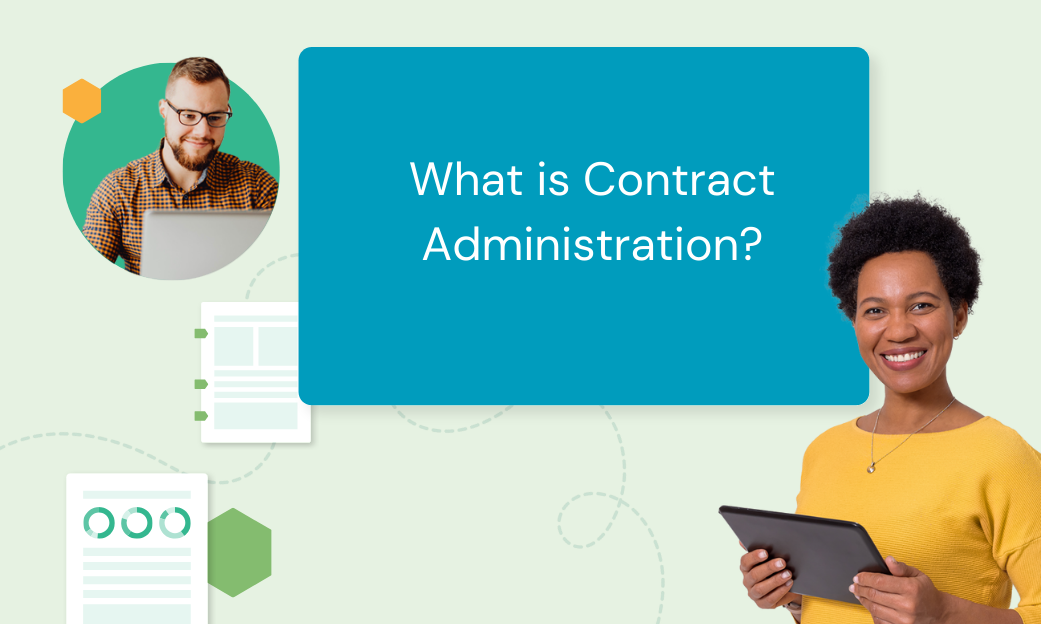Blog
What is Contract Administration?

Contract administration forms a core part of the contract lifecycle. Though it overlaps significantly with contract management, they’re not identical, and any organization dealing in contracts needs to ensure they’ve designed the administration process effectively. In this guide, we’ll explore how contract administration differs from contract management, along with its key stages and best practices.
Introduction to Contract Administration
Contract administration is core to the contract lifecycle, comprising every stage in the process until the contract is signed. Let’s take a closer look at what it involves.
What is Contract Administration?
Contract administration is the part of a contract lifecycle that starts with data gathering and drafting, and ends with all parties signing. Though it doesn’t encompass the whole contract lifecycle, it constitutes its biggest part. Without effective contract administration, firms can run into trouble ranging from poorly drafted contracts to legal noncompliance.
Contract Administration vs. Contract Management
Contract administration is sometimes confused with contract management. This is understandable, as they involve significant overlap. However, they aren’t the same. Let’s explore their similarities and differences.
Key Differences
Contract management is the process of overseeing all stages in a contract lifecycle. This includes:
- Data gathering and planning – Collecting and organizing everything that will go into the contract.
- Document drafting and review – Writing and internally revising the drafts.
- Negotiation – Passing the draft by all parties for approval (and any necessary changes).
- Signing – All parties sign the document.
- Execution/completion – All parties fulfill the contract terms or terminate per the agreement.
- Storage and retrieval – Compliantly store contracts; retrieve key information for audits or research.
In contrast, contract administration begins with gathering, planning, and drafting, ending when all parties have signed. Contract management, however, extends over the administration phase to the end of the contract lifecycle.
How They Complement Each Other
A large proportion of contract management involves the contract administration phase. In fact, this may be its most intensive stage. As such, a well-designed contract management solution can be crucial to a well-run contract administration process.
4 Key Stages in Contract Administration
Contract administration involves several stages that can be streamlined using the right tools. Let’s take a closer look.
1. Data Gathering and Planning
This stage involves collecting any documents and information that should be referenced or included in the contract itself, along with any planning necessary to ensure an effective contract. If you’re using an AI document generator, you may also craft your prompts at this stage.
2. Drafting and Internal Revisions
During this phase, you’re incorporating the information and components you organized into an initial draft. Again, this may be manual or automated. From here, you will revise and refine the draft with colleagues until it meets internal requirements. Collaborative contract administration tools can make the human revision process much easier by centralizing revisions and communication.
3. Negotiation
Now it’s time to ensure the contract meets all parties’ requirements. The draft will be routed to key stakeholders, who will either approve the document or suggest changes. Contract negotiation automation can significantly save time and reduce oversights at this stage by automating the routing process and sending reminders when necessary.
4. Signing
When the final contract draft has been approved, it’s routed to stakeholders for signatures. An integrated eSignature tool can greatly improve this process, automating routing and allowing all parties to submit legally-binding signatures in one place and document version.
This concludes the contract administration phase – but again, not the contract lifecycle. The contract management strategy will continue to oversee the rest of this process, through to completion and compliant documentation.
Effective Contract Administration: Best Practices
Firms can follow several best practices to ensure their contract administration process runs smoothly.
Documentation and Record Keeping
Although contract administration does not oversee documentation, it does rely on it. Effective contract administration needs reliable access to key data during the contract planning phase. Without it, the process can take longer than necessary, or even leave out crucial information in the drafting stage. One way to streamline this process is to use a tool that keeps all documentation in a compliant, central location and incorporates AI-assisted search and retrieval.
Ensure Legal Compliance
In order for a contract to be binding, its purpose must be legal. Otherwise, the contract is unenforceable. Since contract management involves ensuring all parties comply with contract terms, it’s crucial for the contract administration phase to build legally binding terms into the contract. For example, in California, non-compete clauses are generally illegal, so ensure you know the local regulations before finalizing your contract.
Automate the Process
A large proportion of the contract lifecycle can be automated – so it makes sense to invest in contract administration tools to streamline the process. Specifically, AI can help teams save significant time on the data gathering and drafting stage by automatically analyzing, collecting, and incorporating relevant information into the initial document draft. Meanwhile, contract routing can be automated in a workflow using robotic process automation (RPA). This can mean fewer forgotten tasks, less time waiting for signatures, and automated reminders if a deadline is missed.
Mastering Contract Admin with Docubee
Docubee helps firms automate their entire contract lifecycle, from the contract administration phase through to the end of a contract’s lifecycle. Optimizing contract administration is a core part of what Docubee’s contract management platform specializes in. Firms can intelligently automate every stage of the process with a hybrid approach that uses both AI and robotic process administration. Our customers discover new efficiencies like:
- AI-driven data analysis and contract generation
- Centralized collaboration as stakeholders revise the contract
- Automated contract routing and reminders
- Integrated eSignatures
Help your team fly straight to their goals. Learn about contract lifecycle management from Docubee.




